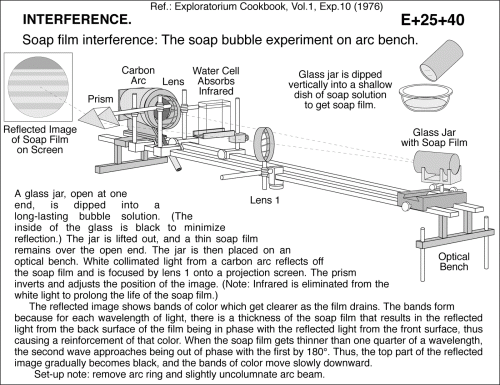Soap film interference: The soap bubble experiment on arc bench.
Primary tabs
A glass jar, open at one end, is dipped into a long-lasting bubble solution. (The inside of the glass is black to minimize reflection.) The jar is lifted out, and a thin soap film remains over the open end. The jar is then placed on an optical bench. White collimated light from a carbon arc reflects off the soap film and is focused by lens 1 onto a projection screen. The prism inverts and adjusts the position of the image. (Note: Infrared is eliminated from the white light to prolong the life of the soap film.) The reflected image shows bands of color which get clearer as the film drains. The bands form because for each wavelength of light, there is a thickness of the soap film that results in the reflected light from the back surface of the film being in phase with the reflected light from the front surface, thus causing a reinforcement of that color. When the soap film gets thinner than one quarter of a wavelength, the second wave approaches being out of phase with the first by 180 deg . Thus, the top part of the reflected image gradually becomes black, and the bands of color move slowly downward. Set-up note: remove arc ring and slightly uncolumnate arc beam. Soap film interference: The soap bubble experiment on arc bench. Ref.: Exploratorium Cookbook, Vol.1, Exp.10 (1976) Glass jar is dipped vertically into a shallow dish of soap solution to get soap film.
UCB Index:
E+25+40
PIRA Index:
6D30.20
UCB Taxonomy:
PIRA Taxonomy:
Video:
Popularity:
- Log in to post comments

